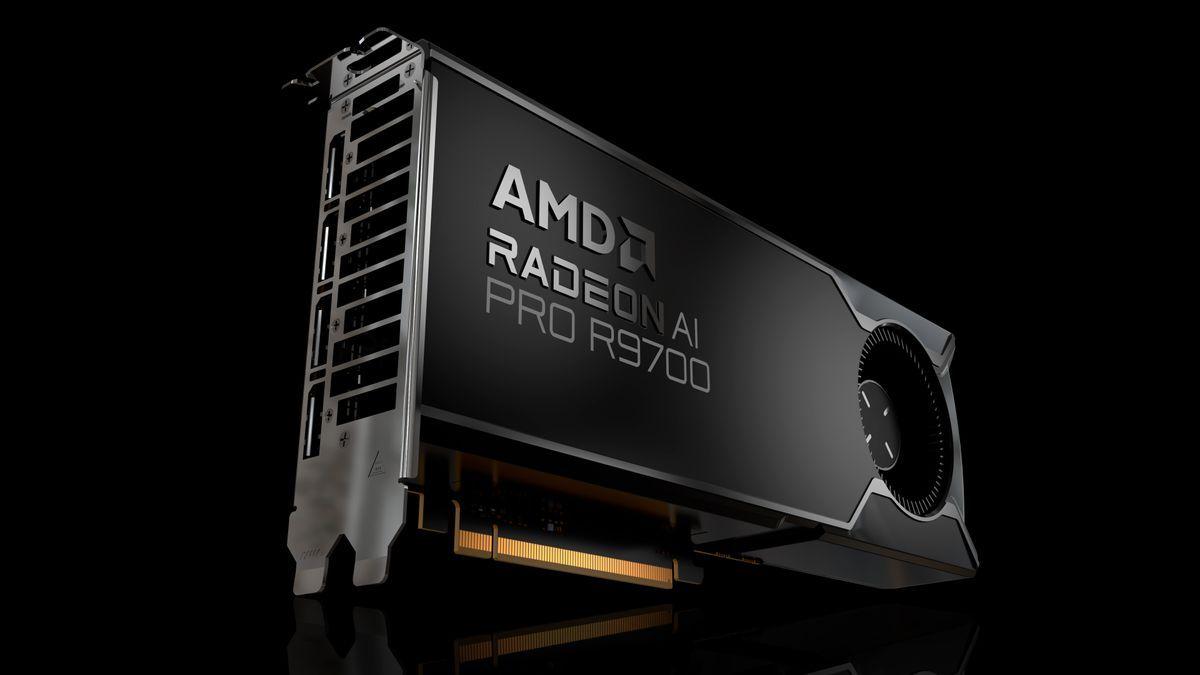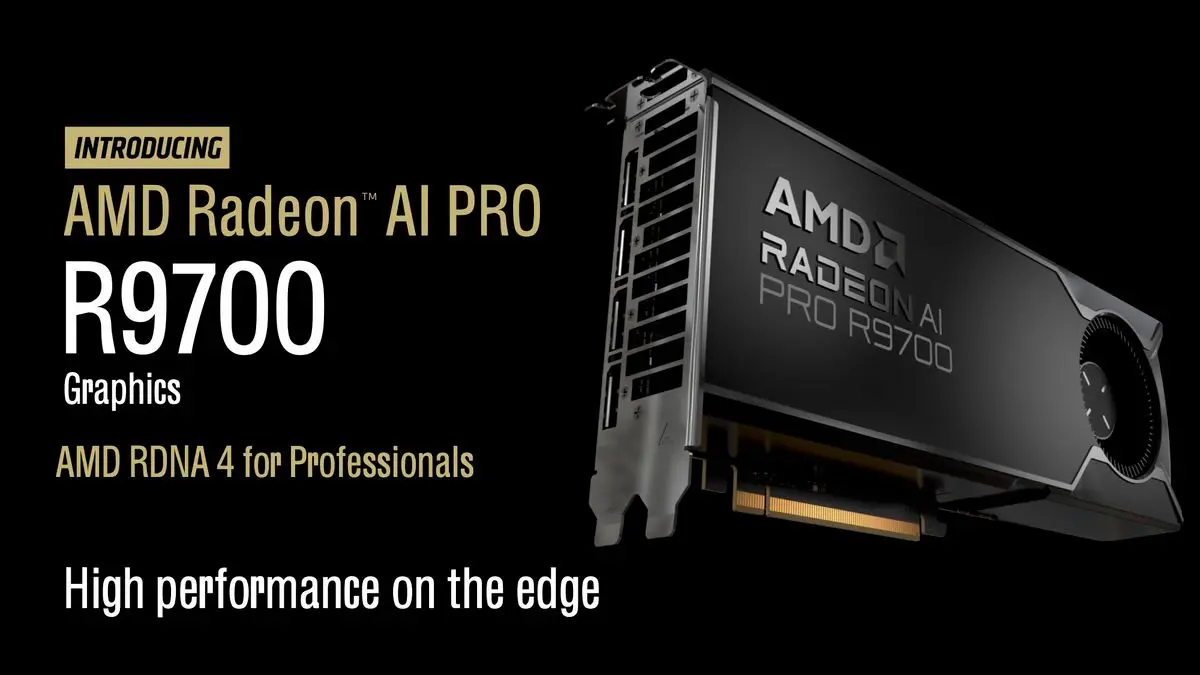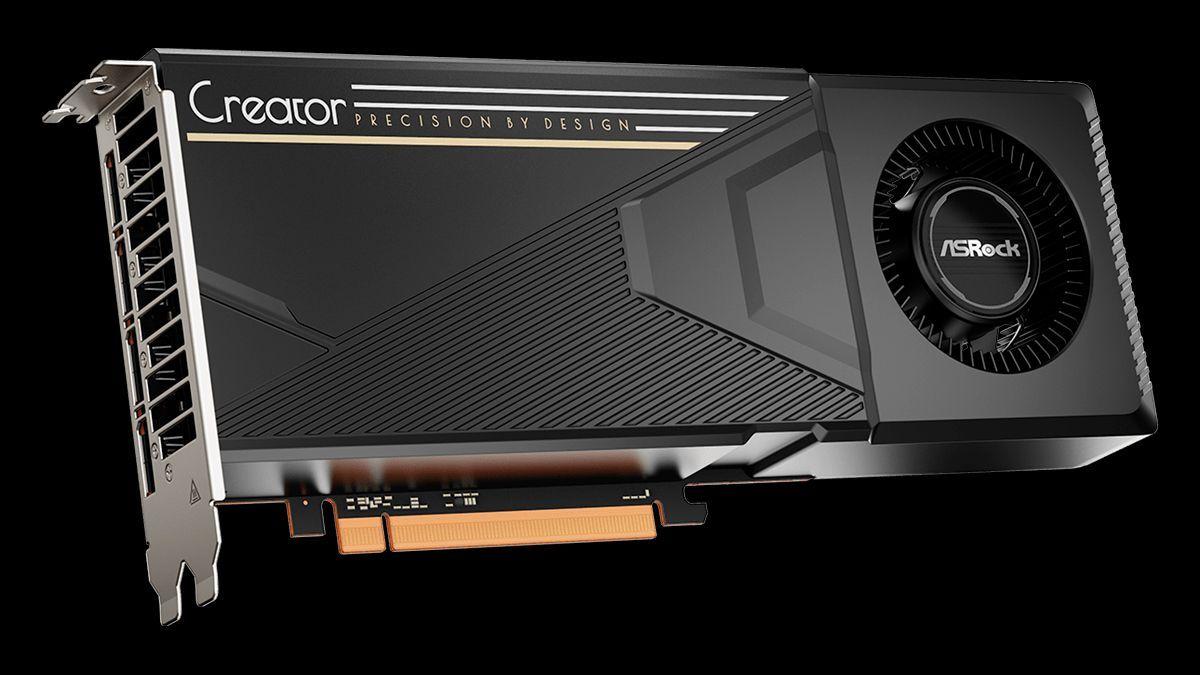AMD Radeon AI PRO R9700: A Powerful New Contender in AI Workstation GPUs
5 Sources
5 Sources
[1]
AMD Radeon AI PRO R9700 32 GB GDDR6 Price and Release Date
The Radeon AI PRO R9700 32 GB graphics card from AMD has finally cleared the pricing hurdle. After its Computex 2025 unveiling, industry reports indicate that its reference price will land between $1,240 and $1,277, with the sweet spot around $1,259. AMD hasn't officially confirmed the MSRP yet, but given that range, most expect the company to peg it at roughly $1,259 when it goes on sale. Under the hood, the R9700 relies on the NAVI 48 GPU, part of AMD's latest RDNA 4 lineup. What really sets this PRO variant apart is its hefty 32 GB of GDDR6 memory. By comparison, the gaming-focused Radeon RX 9070 XT shares the same core but comes with only 16 GB of frame buffer. Doubling that capacity on the PRO model means you can handle far larger data sets, which translates into smoother performance in professional rendering tasks, scientific compute jobs, and AI inference processes. If you're building out a high‑performance workstation, the extra memory won't just sit there -- it'll let your software cache more information directly on the GPU. Think large 3D scenes, extensive texture libraries, or machine learning models with millions of parameters. The extra headroom should reduce memory swapping to system RAM, which can bottleneck throughput in demanding workflows. AMD plans to roll out the Radeon AI PRO R9700 in July 2025, sticking to the timeline hinted at during Computex. You'll see board partners like ASRock, ASUS, GIGABYTE, PowerColor, Sapphire, XFX, and Yeston each bring their own board designs to market. Those custom variants will likely feature different cooling solutions and factory overclocks aimed at professional users, while still maintaining the core PRO feature set. Pricing around $1,259 positions the R9700 PRO firmly in the professional segment, just above mid‑range gaming GPUs but below ultra‑high‑end accelerators designed exclusively for data centers. For enterprises and freelancers alike, it offers a balance of raw compute power and ample VRAM, making it suitable for mixed tasks like content creation pipelines, real‑time visualization, and smaller scale AI development. It's worth noting that while the final price tag and exact street availability date are pending, most retailers and channel partners will begin quoting it once AMD confirms the MSRP. If you need one for your next project, it makes sense to start conversations now with your preferred system integrator or reseller. That way, you'll be in line to get a card as soon as they hit warehouses. Source: benchlife
[2]
AMD Radeon AI PRO R9700 GPU Launch Date and Specifications
The AMD Radeon AI PRO R9700 is set to hit the market on July 23, 2025. Initially, you'll find it in complete workstation packages from companies like Boxx and Velocity Micro, while DIY enthusiasts can expect standalone boards from ASRock, PowerColor, and other partners later in the third quarter. Early price estimates put the R9700 at about USD 1,250, sitting between the RX 9070 XT's USD 599 tag and pricier NVIDIA workstation cards. Under the hood, the R9700 uses AMD's Navi 48 GPU die and RDNA 4 architecture. It comes with 32 GB of GDDR6 memory and supports PCIe 5.0, which helps feed all that data quickly. This card is especially tuned for AI tasks that use lower-precision math -- FP8, FP16, and INT8 -- and AMD claims it can run large transformer models almost five times faster than NVIDIA's desktop RTX 5080. One of the biggest advantages of the R9700 is its large VRAM capacity. Many GPUs have to shuffle data between VRAM and system RAM when models get big, but the R9700 can handle full-model inference and on-device fine-tuning entirely in its 32 GB buffer. That means lower latency, higher throughput, and a fully on‑premises workflow -- no cloud uploads required. It's a big plus for teams working with sensitive data or those who need tight control over performance. On the software side, the card is fully compatible with AMD's ROCm 6.3 platform. You'll get out‑of-the-box support for major AI frameworks like PyTorch, ONNX Runtime, and TensorFlow. That integration streamlines everything from initial development to final deployment, so you can prototype, test, and run real workloads without wrestling with compatibility issues. The R9700's dual-slot blower cooler pushes air front-to-back, which is crucial if you're packing multiple cards into a single chassis. Axial fans on consumer cards can struggle in tight spaces, but the blower design helps maintain consistent airflow across several GPUs. It's ideal for building high-density inference servers or expanding memory by linking cards together. This card is aimed at AI professionals tackling tasks like natural language processing, generative design, text-to-image creation, and other workflows that demand large datasets and complex models. With 32 GB of VRAM, robust RDNA 4 compute, and ROCm support, it's designed to keep everything running locally, from big-model inference to custom fine‑tuning. If you want to try before you buy, AMD offers the Radeon Test Drive program. It provides remote access to ROCm 6.4.1 environments running on Radeon PRO hardware, so you can benchmark your own frameworks and model pipelines without investing in physical hardware right away. Applications are open now on AMD's developer site.
[3]
AMD's new Radeon AI PRO R9700 workstation GPU drops on July 23: full Navi 48 die and 32GB GDDR6
As an Amazon Associate, we earn from qualifying purchases. TweakTown may also earn commissions from other affiliate partners at no extra cost to you. AMD has confirmed that it will be launching its new Radeon AI PRO R9700 workstation-ready graphics card on July 23, built on the full-fat Navi 48 GPU die and features 32GB of GDDR6 memory. The company has specifically tuned the new Radeon AI PRO R9700 graphics card for lower-precision calculations and demanding AI workloads, with AMD noting that it delivers up to 496% faster inference on large transformer models compared to NVIDIA's Blackwell-based GeForce RTX 5080. AMD's new Radeon AI PRO R9700 will also be around half the price of NVIDIA's new RTX PRO Blackwell GPUs, with the Radeon AI PRO R9700 at launch being offered only inside turnkey workstations from OEM partners like Boxx and Velocity Micro. Enthusiasts wanting to get their hands on the new RDNA 4-powered Radeon AI PRO R9700 workstation graphics card will have to wait until later in Q3 2025, with AIB partners like ASRock, PowerColor, and others preparing their own solutions. Early listing prices suggest we can expect a price of around $1250 for the Radeon AI PRO R9700, which is considerably more than the $599 pricing on the Radeon RX 9070 XT, yet considerably lower than workstation GPUs from NVIDIA. AMD's new Radeon AI PRO R9700 excels in natural language processing, text-to-image generation, generative design, and other high-end workloads that rely on large models and memory-intensive pipelines. The included 32GB of VRAM allows for production-scale inference, local fine-tuning, and multi-modal workflows to run entirely on-premise, without reaching out to the cloud. This means you've got more performance, lower latency, and increased data security when compared to cloud-based solutions. We've also got full compatibility with AMD's open ROCm 6.3 platform, which provides developers with access to leading frameworks like PyTorch, ONNX Runtime, and TensorFlow. This means AI models can be built, tested, and deployed efficiently on local workstations, again, without using the cloud. The Radeon AI PRO R9700 debuts in a sleek dual-slot design with a blower-style cooler, which means multi-GPU configurations are easy to do, making it simple to expand memory capacity, deploy parallel inference pipelines, and sustain high-throughput AI infrastructure in enterprise environments.
[4]
AMD Announces 23rd July As The Official Launch Date For Radeon AI PRO R9700 And Threadripper PRO 9000 WX-Series
The RDNA 4-based workstation graphics card and the Threadripper PRO 9000 WX-Series will be available starting on 23rd July. AMD has today announced the official retail launch date for its latest products in the CPU and GPU segments. The company showcased its latest Threadripper PRO 9000 WX series and the RDNA 4-based workstation graphics card at Computex and announced previously that the products will be launching in July. Today, it announced 23rd July as the official retail launch date for both of these products in two different blog posts. To meet this demand, AMD is pleased to announce the upcoming availability of workstation systems featuring the AMD Radeon™ AI PRO R9700 - its most advanced professional graphics for local AI development and high-throughput inference. These GPUs will be available in pre-built workstation systems starting July 23, 2025, from select AMD hardware partners specializing in custom, high-performance computing solutions. - AMD AMD's RDNA 4-based Radeon AI PRO R9700 is its latest workstation GPU, which it showcased recently at Computext. The GPU features the NAVI 48 die, which is also used in the RX 9070 series, but the R9700 is specifically created for specialized workloads such as professional programs and AI operations. Equipped with 32 GB GDDR6 memory through a 256-bit memory interface and offering 128 AI Accelerators, the GPU is sufficient for modern AI workloads and offers up to 496% higher performance compared to RTX 5080 in Large AI models. The Radeon AI PRO R9700 won't be available for individual purchase and will only be available through pre-built workstation systems from select AMD hardware partners. As for the Ryzen Threadripper PRO 9000 WX series, we recently reported that a major NA retailer will take pre-orders starting on 23rd July. Apparently, this is also the official launch date for these Zen 5 workstation processors, made for enterprises. Announced a few weeks ago at Computex, the new Threadripper PRO 9000 WX-Series will be available in systems from AMD's regional system integration partners as well as global OEMs, including Dell Technologies, HP, Lenovo and Supermicro starting July 23. DIY customers will also be able to purchase the new processors individually through AMD's global network of channel partners. - AMD The Threadripper PRO 9000 WX series offers leading performance in professional tasks and AI workloads, and brings up to a 96-core configuration on its flagship offering, the Threadripper PRO 9995WX. As per AMD's internal testing, the Threadripper PRO 9995WX offers up to 26% higher performance compared to its predecessor. Compared to the Intel Xeon W9-3595X, the CPU reportedly delivers up to 495% higher AI performance.
[5]
AMD Radeon AI PRO R9700 32 GB GPU Listed Online, Pricing Expected Around $1250, Half The Price of NVIDIA's RTX PRO "Blackwell" With 24 GB VRAM
The first AMD Radeon AI PRO R9700 GPUs, packing 32 GB of memory for AI workloads, have been listed online with prices over $1000 US. At Computex, AMD unveiled its latest workstation GPU, the Radeon AI R9700, specifically designed to meet the rising AI demands. Featuring the same, and full-fat Navi 48 GPU which we saw on the Radeon RX 9070 XT, the graphics card came with one major upgrade, and that was its 32 GB VRAM, double that of the 9070 XT. The large VRAM was designed to meet the requirements of the most popular LLMs, which typically scale between 16-28 GB. With 32 GB, AMD is ensuring that the Radeon AI PRO R9700 has all that it would take to run these models efficiently. Although the card has been announced since May 2025, there have been few to no details on the pricing said except the fact that AMD itself mentioned that the perf/$ of the Radeon AI PRO R9700 would be very good against the competition. It looks like we finally have an update on the pricing side, and it does look highly competitive. To start, the retailer, Tech-America (via Melodic Warrior @ X), has listed three variants of the Radeon AI PRO R9700. One of these is from ASRock, while two are from Sapphire (essentially the same model). The cards have been listed between $1244 $1277 US, which means that we can expect a price between $1200-$1250 US if these preliminary listings hold. The reason we also believe that this is going to be a highly competitive product is because when we compare the price to the competition's most entry-level product, the Radeon AI PRO R9700 looks too good. For example, the NVIDIA RTX PRO 4000 "Blackwell" GPU is listed for $2499 US, and packs 24 GB VRAM. It uses the same GPU as the RTX 5070 Ti but with a cut-down 192-bit bus. The RTX PRO series does have GDDR7 memory versus AMD's GDDR6, but VRAM capacity is more important for AI workloads, and AMD has a win. NVIDIA's 32 GB offering, the RTX PRO 4500 "Blackwell" GPU retails for $3799 US, and would be 3 times more expensive than the Radeon AI PRO R9700. It does have the same GPU as the RTX 5080. As for the overall performance, AMD's AI / ROCm stack is being upgraded too, so we can see some very decent AI figures. NVIDIA still holds the edge in compute capabilities with its Blackwell architecture, but AMD has a solid chance to hit NVIDIA's 24 GB and 32 GB offerings. AMD also recently shared some additional test results for its Radeon AI PRO R9700, which you can check out here. The AMD Radeon AI PRO R9700 launches this month, so we are going to be looking at a competitive landscape in the workstation AI segment. Now, it's up to Intel to hurry up and launch its B60/B50 Arc PRO GPUs, as those also hold a chance to compete in the perf/$ segment.
Share
Share
Copy Link
AMD is set to launch its Radeon AI PRO R9700 GPU on July 23, 2025, offering high performance for AI workloads at a competitive price point.
AMD Unveils Radeon AI PRO R9700: A New Powerhouse for AI Workstations
AMD is set to shake up the AI workstation market with its upcoming Radeon AI PRO R9700 graphics card, scheduled for release on July 23, 2025
1
2
3
4
. This new offering aims to deliver high-performance AI capabilities at a competitive price point, potentially disrupting the current landscape dominated by NVIDIA.Specifications and Performance

Source: TweakTown
The Radeon AI PRO R9700 is built on AMD's latest RDNA 4 architecture, featuring the full Navi 48 GPU die
1
2
. Its standout feature is the generous 32GB of GDDR6 memory, double that of its gaming counterpart, the Radeon RX 9070 XT1
3
. This increased VRAM capacity is crucial for handling large AI models and datasets without relying on system RAM or cloud resources.AMD claims the R9700 can deliver up to 496% faster inference on large transformer models compared to NVIDIA's GeForce RTX 5080
2
3
. The card is optimized for lower-precision calculations (FP8, FP16, and INT8) commonly used in AI tasks2
. It also supports PCIe 5.0 for rapid data transfer and is compatible with AMD's ROCm 6.3 platform, ensuring out-of-the-box support for major AI frameworks like PyTorch, ONNX Runtime, and TensorFlow2
.Pricing and Positioning
Early listings suggest a price range of $1,240 to $1,277, with expectations settling around $1,259
1
5
. This positioning places the R9700 firmly in the professional segment, above mid-range gaming GPUs but significantly below high-end data center accelerators1
. Notably, it's priced at roughly half the cost of NVIDIA's RTX PRO Blackwell GPUs with 24GB VRAM, potentially offering a compelling value proposition5
.Availability and Market Strategy

Source: Wccftech
Initially, the Radeon AI PRO R9700 will be available in pre-built workstation systems from partners like Boxx and Velocity Micro
2
4
. DIY enthusiasts and individual buyers will need to wait until later in Q3 2025 for standalone cards from AIB partners such as ASRock, ASUS, GIGABYTE, PowerColor, Sapphire, XFX, and Yeston1
2
3
.Related Stories
Target Applications and Use Cases
The R9700 is tailored for AI professionals working on:
- Natural language processing
- Text-to-image generation
- Generative design
- Other high-end workloads requiring large models and memory-intensive pipelines
2
3
Its 32GB VRAM allows for production-scale inference, local fine-tuning, and multi-modal workflows to run entirely on-premise, enhancing performance, reducing latency, and improving data security compared to cloud-based solutions
3
.Cooling and Form Factor

Source: Wccftech
The card features a dual-slot blower-style cooler, which is ideal for multi-GPU configurations and high-density server setups
2
3
. This design choice facilitates better airflow in cramped spaces, making it suitable for expanding memory capacity or deploying parallel inference pipelines in enterprise environments.As the launch date approaches, AMD's Radeon AI PRO R9700 appears poised to offer a compelling alternative in the AI workstation GPU market, potentially challenging NVIDIA's dominance with its balance of performance, memory capacity, and competitive pricing.
References
Summarized by
Navi
[3]
Related Stories
Recent Highlights
1
Google launches Gemini 3 Flash as default AI model, delivering speed with Pro-grade reasoning
Technology

2
OpenAI launches GPT Image 1.5 as AI image generator war with Google intensifies
Technology

3
OpenAI launches ChatGPT app store, opening doors for third-party developers to build AI-powered apps
Technology








